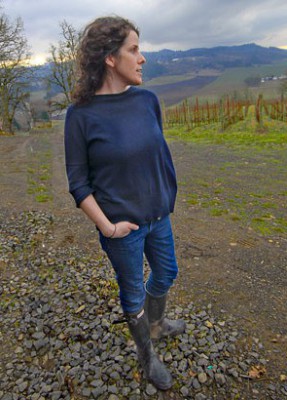
So, it should be stated up front, I really like the 2011 Oregon Pinots. Lighter sure, but for good producers the quality is sound and the aromatics are remarkable. Maggie Harrison, who although has been making superb Pinots on her own for a decade, is always framed by her time with Manfred Krankl at Sine Qua Non. There I did it myself. But the winery does it on their own website. She was there nine years, so I suppose it was game changing. Still, this is her own show, and this wine has little to do with the central coast wines she made with Krankl. It is all finesse. And that is the real story here.

Review: 2011 Coriolis Pinot Noir, Willamette Valley
Wow. This is extremely aromatic; soaring, almost an exploding perfume of potpourri-like spice, cedar, black fruits, vague stem notes and forest floor, high notes of pine and resin with dried cranberries. The mouth is broad and soft with black fruit at its core, again some stem and pine flavors that almost structurally holding this soft but long and expansive wine together. The weight of the wine is medium, but the finish while long is weightless, something I cherish, but others complain of bitterly as if it’s a fault. This is a beautiful wine, long and so silky with an airy finish, the aromas lingering, wafting as the alcohol volatilized, long after the wine is swallowed. Just delicious, with elements that make me think this easily could be confused with a very good Burgundy or even a very high-level Beaujolais, I find this wine very successful. For others, this beautiful wine might be dismissed as too light. Utter silliness. 93 points for me. $54
The Winery and Geology of the vineyard
Coriolis is the second wine of Antica Terra label, where Harrison was brought on as winemaker and partner to push up the quality a decade ago. Indeed, with her talent, she has put them on the map. The winery name refers the ancient soils of the vineyard that the original owners planted in 1989. Unique to the region, an ancient indurated seabed has pushed to the surface on this vineyard spot and has been encircled by the much younger, fertile soils that flow around it. The Antica Terra vines are planted directly into fractured sandstone that is studded by fossilized oyster shells. Harrison reports (and sometimes worries) about the underdeveloped and frail nature of her twenty-year-old vines. While a vine’s roots can reach deep into soil and rock for water, it is their root system near the surface from which vines get most of their nutrients. Perhaps she has reason to worry: vines in Burgundy that are planted to limestone sites with very little topsoil have difficulty achieving old age. She describes chlorosis when she writes:”The smallest changes in the environment can cause the leaves to turn yellow and fall.” This too happens in Burgundy, where acidic ground water that has eroded limestone can form a casing around the roots inhibiting iron intake causing chlorosis. She mentions fossilized oyster shells, and it is interesting to note that the difference between the two sandstone and limestone is that limestone consists of 50% or more of calcium carbonate (CaCO3) which is derived (in Burgundy) from marine life, like oysters. In any case, these vines are certainly not well nourished, but with extreme care, and very careful fruit selection, the wines coming from this vineyard are routinely superb.
Giving to Charity: Coriolis is a side project where 100% of the profits are donated to the Phil Knight Cancer Challenge.
.

